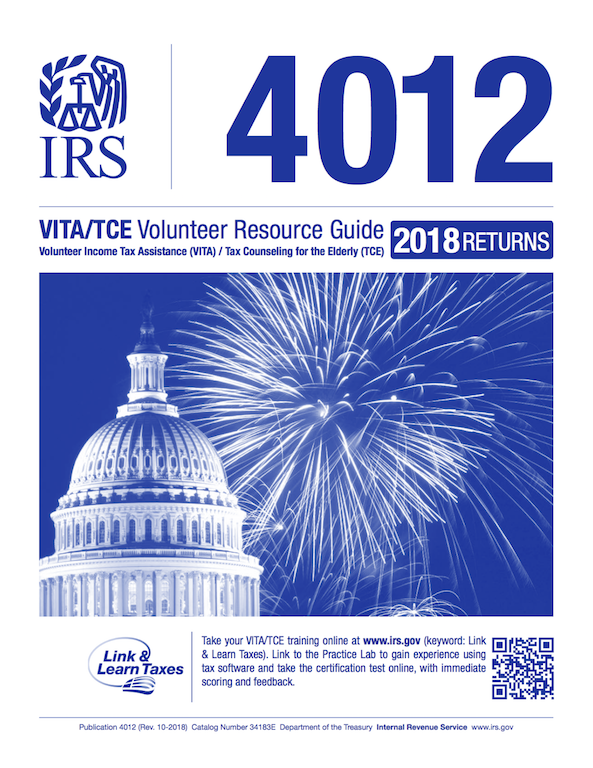Classroom training
Thank you for donating your time and talents to AARP Tax-aide!
Click on the images above to open up the electronic versions of these documents.
[If you are experiencing trouble getting into your AARP New Volunteer Portal account, try this procedure (click) to remedy issue.]
Click on the calendar arrows alongside the month/year to see upcoming events and important dates.
What to expect
What to Bring to Class
2018 Pub 4012 - Volunteer Resource Guide
[This is being issued by IRS in January.]Laptop (if you have one) with its power cord and a surge protector
2018 NTTC workbook - you should have this if you attended one of the workshops. Otherwise, a copy will be provided.
Name badge (if you’re a returning volunteer)
It’s time to begin preparing for classroom training. This page is designed to help you get organized for each day of instruction, software workshops and demonstrations.
During classroom instruction, there will be specific tax topics covered, illustrating examples for different types of income, deductions, and for the tax credits we commonly see at tax sites throughout filing season.
Getting setup ahead of class is an important step in achieving the maximum benefit in the use of your time. We don’t want to waste your time with simple administrative tasks.
Pre-class setup tasks:
Setup your personal account in the TaxSlayer® Practice Lab.
Create a taxpayer return that will be used in class
Pre-read/review the topic materials that will be presented
STEP 1. Setup your TaxSlayer® Practice Lab account
Click one of these links to launch the TaxSlayer® Practice Lab (PL). They all take you to the same software, TaxSlayer® Practice Lab, through different landing pages.
It is suggested that during training you use the Link & Learn link (the third entry in list below) because it is a one-stop shop where you will access training material, Practice Lab, and the certification tests.
In an effort to keep this page streamlined to steps for classroom training, if you need to setup your Practice Lab account or are having trouble, click link below to go to the page with those instructions and then return here to continue with Step 2.
STEP 2. Create a tax return in Practice Lab
We will be using and reusing this taxpayer return to illustrate what happens when specific entries are changed.
From page 33 in the NTTC Workbook.
Enter the BASIC information for
Training Exercise for Evans/Bryant.
Please just enter the Names, Address, Birthdates, Social Security Numbers.
STEP 3. Read Ahead
For each day and for each topic on the agenda, you will be asked to review the sections of whichever online training method you prefer. (see below)
This reading is for awareness only.
As volunteer tax preparers, it is necessary to be aware of a lot of things, but will actually encounter a very small number of them.
Nothing needs to be or should be memorized. It is an ‘open book’ environment. Your training and tests are open book and so is the tax season; if you aren’t sure about something at any time, please feel at ease to look it up.
Expectation
The expectation is that everyone attending this training will have reviewed the material prior to coming to class.
Lectures will be limited to
Highlighting the key points of each topic (using Pub 4012) and
Using the tax software to practice how that topic/issue is handled in the tax software
Your instructors will
emphasize how to handle the tax issues/documents encountered most frequently.
briefly mention items that are sometimes seen, but not often.
[for awareness only, pointing out where to find the resource to handle a seldom seen item]
Tax-Aide Training Materials
For each CLASS TOPIC listed in the left-most column (below), please choose any ONE of the three resource publications (across horizontal headings) to prepare for class.
Please review each topic listed for the following class day, your goal is to have an idea of WHAT and HOW the topic relates to in the tax preparation process, ie. interaction/interview with the taxpayer or where the topic item fits into the tax return itself such as taxable income or deductible expense.
It may be useful to have a blank Form 1040 (see Pub 4012, p B-1) available to help you see WHERE the item belongs on the tax return.
Click here to reference Pub 4012, p B-1 while you review. This is a marked-up 1040 that indicates what tabbed section of Pub 4012 contains the guidance for each line item.
Due to the Form 1040 redesign for 2018, many of the line items that were found directly on the 2017 Form 1040, have been offloaded onto one of six new Schedules. Some of these items will be covered in Day 1. They are found on Schedules 1 and 6.
Schedule 1 - Additional Income and Adjustments to Income
Schedule 6 - Foreign Address and Third Party Designee
DAY 1 - New Volunteers
Topic
Overview of Process
Scope of Tax-Aide Program
Who MUST/Should File
Filing Status
Dependency
Income
W-2 (boxes & codes)
Interest
(+) Additional Income
Schedule 1
Alimony received
Unemployment Comp.
Other Income
Cancellation of Debt
Gambling Winnings
(-) Adjustments to Income
Schedule 1
IRA Deduction
Early Withdrawal Penalty
Student Loan Interest
Standard Deduction
TAX
Nonrefundable Credits
Retirement Savers Credit
Child Tax Credit
Dependent Care Credit
Refundable Credits
Earned Income Credit
Pub 4012
Scope of Service
Tab A: Who Must File
Tab D: Income
Tab D: Other Income
Tax assessed by Filing Status
I-1 through I-5 (eligibility decision trees, etc)



